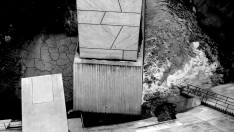Constructions of Los Angeles

Devil's Gate (2011) by Laura Kraning
Filmmakers Laura Kraning and Baylis Glascock in person!
More than most cities, Los Angeles is one that is thoroughly invested with the idea and practice of construction and reconstruction. It is the place where people go to reconstruct themselves, and it is a city whose built environment is always being constructed, torn down, and reformed, in space and meaning. The filmic explorations of lost pasts and present histories vary as widely the possibilities of cinema, and we’re exploring many of those possibilities, from home movie documents to animations of lost neon, from brand new works revisiting old cinematic representations, to careful explorations of the great geometries of the Southern California basin.
In association with Pacific Standard Time Presents Modern Architecture in L.A., Filmforum is doing four screenings with films looking at the built environment and personal meanings of architecture in Los Angeles. The first is a program called This Is the City on Thursday, July 11 at MOCA; the second is this show, July 14th at the Egyptian; the third, featuring Fabrice Ziolkowski’s L.A.X, is July 21st at the Egyptian; and the fourth, featuring Heinz Emigholz’s Schindler’s Houses and Thom Andersen’s Get Out of the Car, at LACMA on July 26th.
Tonight’s program includes some very rare documents of old Los Angeles from that Academy Film Archive, a classic deconstruction of the Watts Towers by Baylis Glascock; and several new works exploring the mysteries of the built and lost past and present of Los Angeles, by filmmakers Laura Kraning, Stephen Connelly (from England), and Johann Lurf from Austria.
Curated by Mark Toscano and Adam Hyman
This program is supported by the Los Angeles County Board of Supervisors through the Los Angeles County Arts Commission; the Department of Cultural Affairs, City of Los Angeles; and the Mike Kelley Foundation for the Arts. Additional support generously provided by American Cinematheque. We also depend on our members, ticket buyers, and individual donors.
Home movie of the building of Los Angeles City Hall 1926
Directed by Newcomb Condee & Family (1926, 16mm, b/w, silent, 7 min.)
A document of construction of the city’s first architectural moument.
Courtesy of the Academy Film Archive
Home Movie of Hollywood Boulevard and Downtown Los Angeles, 1930
Directed by Stanfield Family (1930, 16mm, b/w, silent, 7 min.)
Courtesy of the Academy Film Archive
Footage of Bunker Hill, ca.1940
Directed by Laure Lourié (ca.1940, 16mm, b/w, silent, 7.5 min.)
Courtesy of the Academy Film Archive
Kent MacKenzie’s film of Bunker Hill from 1956 (screened on July 11 at MOCA) might be more well-known due to its inclusion with screenings of The Exiles, but this remarkable footage, from fifteen years earlier, will also make you marvel at what the city lost when it decided to reconstruct Bunker Hill as the center for the financial and cultural center of the city.
Devil’s Gate
Directed by Laura Kraning (2011, HD, B/W, 20 min.)
Devil’s Gate explores the metaphysical undercurrents of a Southern California landscape scarred by fire. The film lyrically depicts the physical and mythological terrain of Devil’s Gate Dam, located at the nexus of Pasadena’s historical relationship with technology and the occult, and intertwining with its central figure, Jack Parsons, who some believe to have opened a dark portal in this place. The film merges an observational portrait of a landscape transformed by fire, ash and water with a fragmentary textual narrative, providing a view into man’s obsession with controlling and transcending the forces of nature and spirit. It can be seen as unearthing a subconscious of the landscape, as the echoes of the past reverberate in the present and infect our perception and experience of place.
Film Exercise Number One
Directed by Baylis Glascock (1962, 16mm, color, sound, 5.5 min.)
A colorful deconstruction of the Watts Towers. Rediscovered last year as part of Alternative Projections.
